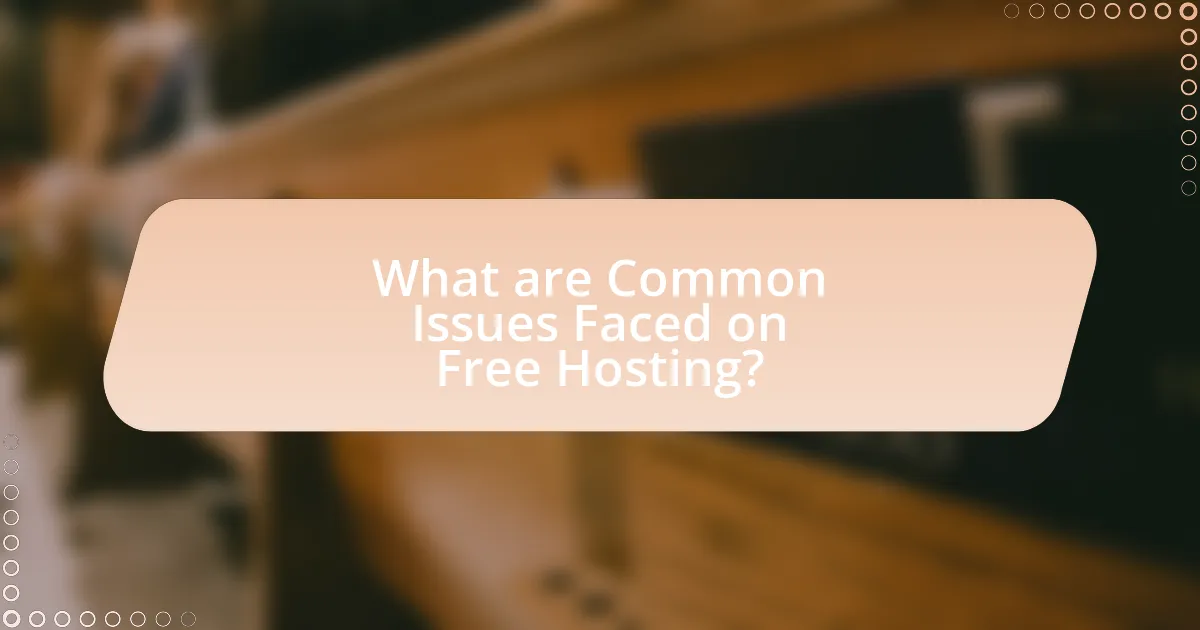The article focuses on troubleshooting common issues encountered with free hosting services. It outlines prevalent problems such as limited storage and bandwidth, lack of customer support, frequent downtime, and restricted features, all of which can adversely affect website performance and user experience. The article further examines the impact of these issues on website functionality, identifies signs of poor performance, and provides effective troubleshooting techniques. Additionally, it discusses the importance of monitoring tools, security measures, and best practices for maintaining a reliable and efficient website on free hosting platforms.

What are Common Issues Faced on Free Hosting?
Common issues faced on free hosting include limited storage and bandwidth, lack of customer support, frequent downtime, and restricted features. Limited storage and bandwidth can hinder website performance and scalability, as many free hosting services impose strict limits that can lead to slow loading times or site unavailability. The absence of reliable customer support often leaves users without assistance during critical issues, making it difficult to resolve problems promptly. Frequent downtime is another significant concern, as free hosting providers may not prioritize uptime, resulting in unreliable access to websites. Additionally, restricted features, such as limited scripting capabilities or the inability to use custom domains, can impede the functionality and professionalism of a website. These issues collectively impact the overall user experience and effectiveness of websites hosted on free platforms.
How do these issues impact website performance?
Website performance is significantly impacted by common issues such as slow server response times, limited bandwidth, and inadequate resource allocation. These factors can lead to increased loading times, which negatively affect user experience and can result in higher bounce rates. For instance, research indicates that a one-second delay in page load time can lead to a 7% reduction in conversions, highlighting the direct correlation between performance issues and user engagement. Additionally, free hosting services often have restrictions that can exacerbate these problems, such as shared resources among multiple users, which can further degrade performance during peak traffic times.
What are the signs of poor performance on free hosting?
Signs of poor performance on free hosting include slow loading times, frequent downtime, limited bandwidth, and lack of customer support. Slow loading times can be measured by page speed tests, often exceeding three seconds, which negatively impacts user experience and SEO rankings. Frequent downtime may be indicated by website outages or error messages, with studies showing that 99.9% uptime is a standard expectation for reliable hosting. Limited bandwidth can lead to throttling, where the website becomes inaccessible during high traffic periods. Lastly, inadequate customer support can be identified by long response times or unavailability of assistance, which can exacerbate issues when they arise.
How can these performance issues affect user experience?
Performance issues can significantly degrade user experience by causing slow loading times, unresponsive interfaces, and frequent downtime. These factors lead to user frustration, increased bounce rates, and decreased engagement. For instance, research by Google indicates that 53% of mobile users abandon sites that take longer than three seconds to load. Additionally, a study from Akamai found that a two-second delay in web page load time can result in a 50% increase in bounce rates. Therefore, performance issues directly impact user satisfaction and retention.
Why do these issues occur on free hosting platforms?
Issues occur on free hosting platforms primarily due to limited resources and lack of support. Free hosting services often impose restrictions on bandwidth, storage, and server performance, leading to slow loading times and downtime. Additionally, these platforms typically do not offer customer support, making it difficult for users to resolve technical problems. According to a study by HostingAdvice, 70% of users reported experiencing performance issues with free hosting due to these constraints.
What limitations do free hosting services impose?
Free hosting services impose several limitations, including restricted bandwidth, limited storage space, and lack of customer support. These constraints often result in slower website performance and potential downtime, as users may experience throttling when traffic exceeds the allocated bandwidth. Additionally, free hosting typically offers minimal storage, which can hinder the ability to host larger files or multiple websites. Furthermore, the absence of reliable customer support can complicate troubleshooting, leaving users without assistance during critical issues.
How does server overload contribute to common issues?
Server overload leads to common issues such as slow response times, downtime, and increased error rates. When a server experiences excessive traffic beyond its capacity, it struggles to process requests efficiently, resulting in delays for users. According to a study by Akamai, a 100-millisecond delay in website load time can decrease conversion rates by 7%. Additionally, server overload can cause frequent crashes, making websites inaccessible, which negatively impacts user experience and trust. This phenomenon is particularly prevalent in free hosting environments where resources are limited, exacerbating the effects of high traffic.

How Can You Identify Specific Issues on Free Hosting?
To identify specific issues on free hosting, users should conduct a systematic evaluation of performance metrics, error messages, and user feedback. Monitoring tools can reveal downtime, slow loading speeds, or server errors, while error logs provide insights into specific problems encountered during website operation. Additionally, user feedback can highlight recurring issues that may not be immediately apparent through technical analysis. For instance, a study by HostingAdvice found that 70% of users experienced performance issues with free hosting services, underscoring the importance of thorough monitoring and user engagement in identifying problems.
What tools can help diagnose problems on free hosting?
Tools that can help diagnose problems on free hosting include website monitoring services, error log analyzers, and performance testing tools. Website monitoring services like UptimeRobot and Pingdom can track website availability and response times, alerting users to downtime or slow performance. Error log analyzers, such as Loggly or Papertrail, allow users to review server logs for error messages that can indicate issues with the hosting environment. Performance testing tools like GTmetrix and Google PageSpeed Insights provide insights into website speed and performance, helping identify bottlenecks that may be caused by the limitations of free hosting services. These tools collectively enable users to pinpoint and address issues effectively.
How do website monitoring tools work?
Website monitoring tools work by continuously checking the availability and performance of a website through automated processes. These tools send requests to the website at regular intervals to assess its uptime, response time, and overall functionality. For instance, if a website goes down or experiences slow loading times, the monitoring tool detects these issues and alerts the website owner or administrator. According to a study by the website monitoring service Pingdom, 40% of users abandon a website that takes more than three seconds to load, highlighting the importance of these tools in maintaining optimal website performance.
What metrics should you focus on when diagnosing issues?
When diagnosing issues in free hosting, focus on metrics such as uptime, response time, error rates, and resource usage. Uptime indicates the reliability of the hosting service, with a target of 99.9% or higher being ideal. Response time measures how quickly the server responds to requests, ideally under 200 milliseconds for optimal performance. Error rates, including HTTP error codes like 404 and 500, help identify specific problems affecting accessibility. Resource usage metrics, such as CPU and memory utilization, reveal whether the hosting environment is overloaded, which can lead to performance degradation. These metrics collectively provide a comprehensive view of the hosting service’s health and performance, enabling effective troubleshooting.
How can you troubleshoot connectivity issues?
To troubleshoot connectivity issues, first check the physical connections, ensuring that all cables are securely plugged in and that devices are powered on. Next, verify the network settings on your device, including IP address configuration and DNS settings, as incorrect settings can lead to connectivity problems. Additionally, restart your modem and router to refresh the connection, as this can resolve temporary glitches. If issues persist, run a ping test to check the connection to the server, which can help identify if the problem lies with the local network or the hosting service. According to a study by the National Institute of Standards and Technology, 70% of connectivity issues can be resolved by checking physical connections and network settings.
What steps should you take to check your internet connection?
To check your internet connection, first, verify that your device is connected to the network by checking the Wi-Fi or Ethernet settings. If connected, test the connection by opening a web browser and attempting to access a website. If the website does not load, restart your modem and router by unplugging them for about 30 seconds and then plugging them back in. After the devices reboot, check the connection again. If issues persist, run a speed test using an online tool to measure your internet speed, which can indicate whether the connection is functioning properly. Additionally, check for any service outages in your area by contacting your internet service provider or visiting their website for updates.
How can DNS settings affect connectivity on free hosting?
DNS settings can significantly affect connectivity on free hosting by determining how domain names are resolved to IP addresses. Incorrect DNS configurations, such as pointing to the wrong nameservers or having outdated records, can lead to website inaccessibility or slow loading times. For instance, if a free hosting provider changes its server IP address and the DNS records are not updated accordingly, users attempting to access the website may encounter errors or delays. Additionally, free hosting services often have limitations on DNS management, which can restrict users from making necessary adjustments, further complicating connectivity issues.

What Are Effective Troubleshooting Techniques for Free Hosting?
Effective troubleshooting techniques for free hosting include checking server status, reviewing error logs, testing connectivity, and optimizing resource usage. First, checking the server status can reveal if the hosting service is experiencing downtime, which is common in free hosting environments. Next, reviewing error logs provides insights into specific issues, such as script errors or configuration problems. Testing connectivity involves using tools like ping or traceroute to identify network issues affecting access to the hosted site. Finally, optimizing resource usage, such as reducing file sizes and limiting the number of simultaneous connections, can alleviate performance problems often encountered with free hosting services. These techniques are essential for maintaining website functionality and performance in a free hosting context.
How can you resolve common performance issues?
To resolve common performance issues on free hosting, optimize resource usage by minimizing resource-intensive processes and utilizing caching mechanisms. Resource limitations in free hosting plans often lead to slow loading times and downtime; therefore, implementing techniques such as content delivery networks (CDNs) and image optimization can significantly enhance performance. For instance, a study by Google indicates that reducing page load time by just one second can increase conversion rates by up to 20%. Additionally, regularly monitoring server performance and adjusting configurations can help identify bottlenecks and improve overall efficiency.
What caching strategies can improve loading times?
Caching strategies that can improve loading times include browser caching, server-side caching, and content delivery network (CDN) caching. Browser caching stores static resources like images and scripts on the user’s device, reducing the need to fetch them from the server on subsequent visits, which can decrease loading times by up to 50%. Server-side caching, such as object caching and page caching, minimizes database queries and speeds up content delivery by storing pre-rendered pages or frequently accessed data in memory. CDNs distribute cached content across multiple geographical locations, allowing users to access data from the nearest server, which can significantly reduce latency and improve loading speeds. These strategies collectively enhance user experience by ensuring faster access to web resources.
How can optimizing images enhance website performance?
Optimizing images enhances website performance by reducing file sizes, which leads to faster loading times. Faster loading times improve user experience and can decrease bounce rates; studies show that a one-second delay in page load time can lead to a 7% reduction in conversions. Additionally, optimized images consume less bandwidth, which is particularly beneficial for websites hosted on free hosting services with limited resources. By implementing techniques such as compression and using appropriate file formats, websites can achieve better performance metrics, ultimately resulting in higher search engine rankings and increased user engagement.
What steps should you take for security-related issues?
To address security-related issues, first, conduct a comprehensive security audit of your hosting environment. This involves checking for vulnerabilities such as outdated software, weak passwords, and misconfigured settings. Regularly updating software and plugins is crucial, as 60% of breaches exploit known vulnerabilities in outdated systems. Implement strong password policies and enable two-factor authentication to enhance account security. Additionally, monitor logs for unusual activity, which can indicate potential breaches. According to the Verizon Data Breach Investigations Report, 81% of hacking-related breaches leverage stolen or weak passwords, underscoring the importance of robust security measures.
How can you identify potential security vulnerabilities?
To identify potential security vulnerabilities, conduct a comprehensive security assessment that includes vulnerability scanning, penetration testing, and code reviews. Vulnerability scanning tools, such as Nessus or OpenVAS, can automatically detect known vulnerabilities in systems and applications. Penetration testing simulates attacks to uncover weaknesses that may not be identified through automated scans. Additionally, reviewing the source code for security flaws, such as improper input validation or outdated libraries, can reveal vulnerabilities. According to the 2021 Verizon Data Breach Investigations Report, 61% of breaches involved vulnerabilities for which a patch was available but not applied, highlighting the importance of regular assessments and updates.
What measures can you implement to secure your free hosting account?
To secure your free hosting account, implement strong, unique passwords and enable two-factor authentication. Strong passwords reduce the risk of unauthorized access, while two-factor authentication adds an additional layer of security by requiring a second form of verification. According to a study by the Cybersecurity & Infrastructure Security Agency, using multi-factor authentication can block 99.9% of automated attacks. Regularly updating your software and plugins also helps protect against vulnerabilities, as outdated systems are often targeted by attackers.
What are the best practices for maintaining free hosting?
The best practices for maintaining free hosting include regularly monitoring website performance, ensuring backups are in place, and optimizing resource usage. Regular monitoring helps identify issues such as downtime or slow loading speeds, which can affect user experience. Implementing a backup strategy is crucial, as free hosting services may not provide reliable data recovery options. Additionally, optimizing resource usage, such as managing bandwidth and storage limits, prevents service interruptions and ensures compliance with the hosting provider’s terms. These practices are essential for sustaining a functional and efficient website on free hosting platforms.
How often should you back up your website data?
You should back up your website data at least once a week. Regular weekly backups help ensure that you can quickly restore your site in case of data loss, corruption, or security breaches. According to a study by the University of Maryland, 30,000 websites are hacked daily, highlighting the importance of frequent backups to mitigate risks associated with cyber threats. Additionally, if you frequently update your content or make significant changes, consider backing up your data daily to capture the latest versions.
What routine checks can help prevent issues on free hosting?
Routine checks that can help prevent issues on free hosting include monitoring server uptime, checking for resource limits, ensuring software updates are applied, and reviewing security settings. Regularly monitoring server uptime helps identify outages quickly, while checking resource limits ensures that the hosting plan is not exceeded, which can lead to service interruptions. Applying software updates is crucial as outdated software can be vulnerable to security threats. Additionally, reviewing security settings helps protect against unauthorized access and data breaches. These practices are essential for maintaining a stable and secure hosting environment.
What tips can help you maximize your free hosting experience?
To maximize your free hosting experience, choose a reliable provider with good uptime and support. Reliable providers often offer better performance and quicker resolutions to issues, which is crucial for maintaining website accessibility. Additionally, familiarize yourself with the hosting platform’s features and limitations, as understanding these can help you avoid common pitfalls such as bandwidth overages or storage limits. Regularly back up your data to prevent loss, and utilize community forums or support resources for troubleshooting assistance. These practices enhance your overall experience and ensure your website runs smoothly.